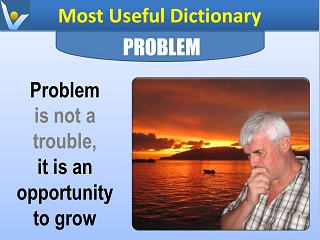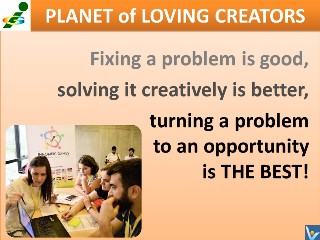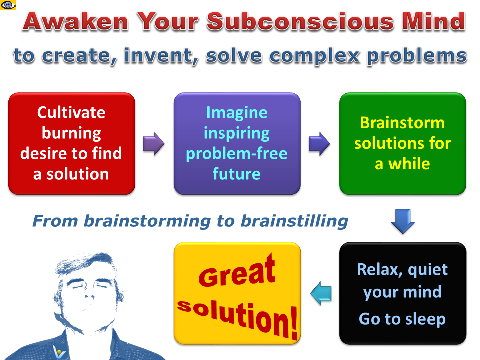|
| |
|
Fixing a problem is good,
solving it creatively is better,
turning it to
an opportunity is the best!
Interpersonal Intelligence
Bonus chapters: NLP Teachings, classic
Teachings
***
Find the right balance and harmony in
your body, your mind, your life, and
your business.
**
YY Hex 11
Yin and Yang represent two fundamental
forces that create and harmonize the
Universe by their interaction.
The State of Peace, Good Fortune, and
Success
In the state of peace, good fortune, and
success (I-Ching, Hexagram 11), Yin, the
Receptive, which moves downward, stands
above; Yang, the Creative, which moves
upward, is below.
Hence their influences meet and are in
harmony, so that all living things bloom
and prosper.
This is the state of peace, good
fortune, and success.
Maintain Strategic Balance
Like everything on Earth, this state of
peace, good fortune and success is
subject to change, however.
Prosperity is followed by decline: this
is the eternal law. Evil can be held in
check for a while but not permanently
abolished. It always returns.
Yet, this is not a tragedy. It shouts
just to keep us from falling into the
illusion that good fortune comes to us
automatically.
If we are mindful of the danger, we
remain persevering and make less
mistakes. As long as your inner nature
remains stronger and richer than
anything offered by external fortune, as
long as you remain inwardly superior to
fate, fortune will not desert you
PROBLEM: SIMPLE SOLUTION
PROBLEM SOLVING: 4 Levels (e-book)
40 one-page lessons specially designed
for inspirational smart & fast
self-learning
https://1000ventures.gumroad.com/l/jekjn
<script src="https://gumroad.com/js/gumroad-embed.js"></script>
<div class="gumroad-product-embed"><a
href="https://1000ventures.gumroad.com/l/jekjn">Loading...</a></div>
PS: 4L (PowerPoint)
https://1000ventures.gumroad.com/l/qmnod
<script
src="https://gumroad.com/js/gumroad-embed.js"></script>
<div class="gumroad-product-embed"><a
href="https://1000ventures.gumroad.com/l/qmnod">Loading...</a></div>
Costas:
This is a great statement dear Vadim. We
tend to getting lost in complexities and
assume that difficult or complex
problems SHOULD have difficult or
complex solutions. Then we ignore simple
and direct solutions which most of the
time are better and easier and faster to
reach to.
****
БИЗНЕС-ОКНО а АЗИЮ
В новых бизнес-реалиях резко возрос
спрос на мой бизнес-тренинг "Особенности
ведения бизнесе в Азии". Посему я его
подкрасил, прирумянил, и приодел.
ВК в контакте
https://vk.com/id687546951
***
A new millennium and new ideas facing
the world. Being aware of the importance
of intelligence matters,
WIN also represents an unprecedented
resource for creative problem solving
for the world at large.
WIN seeks to establish itself as a
global vector for the cultivation and
development of ideas by the most
intellectually gifted people.
The acronym WIN represents a move
towards progress, the hope of a victory
for humanity using all its potential.
This is for those who want to think 200
millions times faster!
Insights by the one who does.
3 Rules for Building YOUR SUBCONSCIOUS
INTUITION
They work for me, and I believe they
will work for you too
"The main factor in any form of
creativeness is the life of a human
spirit, that of the actor and his part,
their joint feelings and subconscious
creation." ~Konstantin Stanislavski
*****
LIFE DESIGN
Chapters:
Models of Life Design
Strategic Life Design
Self-Intelligence
Happiness
Attitudes and Mindsets
Great Habits
Self-Development
***
HAPPY
VICTOR
Master of Happiness
The two main sources of happiness are
enjoying what you have and creating new
things. Happiness is about life-business
synergy: love your life, love what you
have, do what you love to do, and strive
to make other people happier.
Creative Achiever
Follow your heart and intuition. Your
passion will lead you to inspiration and
completion. That's all you need. Follow
your inner direction, not external
suggestions. Don't split your energy. By
trying to chase many rabbits at once,
you'll catch neither. Focus, if you wish
to hit the mark, and pursue your true
passion, if you wish to be creative.
Creativity is your key to a brighter
future. Creativity gives you an
incredible source of adventure,
achievement, self-discovery, connection,
spirituality, awakening, self-worth,
identity, healing, happiness, energy,
and power.
Yin and Yang: the State of Piece, Good
Fortune, and Success
Yin, the Receptive, which moves
downward, stands above; Yang, the
Creative, which moves upward, is below.
Hence their influences meet and are in
harmony, so that all living things bloom
and prosper. This is the state of peace,
good fortune, and success. Like
everything on Earth, this state is
subject to change, however. Yet, if you
are mindful of challenges, you remain
persevering and make less mistakes. As
long as your inner nature remains
stronger and richer than anything
offered by external fortune, as long as
you remain inwardly superior to fate,
success and fortune will not desert you.
|
|
|
|
| |
Problem Defined
A
problem is simply the difference between what you have and what you want.
It may be a matter of getting something, of getting rid of something, of
avoiding something, or of getting to know what you want.
|
 |
| |
Focus on Solutions
Your
attitude is extremely important. When you
think of problems you'll only attract more problems. When you think of
solutions – you'll attract solutions and opportunities. Approach the problem
with the expectant attitude that there is an innovative practical solution
just waiting to be found. Be relaxed, confident and clear in your
mind.
|
 |
| |
Problem Solving Strategies
The best strategy is to avoid potential
problems and
prevent failures, yet problems do occur now and then.
There are many different strategies for solving problems. You need to pick
the strategy that fits the problem best. |
 |
Treat problems as
opportunities
because that's what they are!

→
6 Mindsets
of a
Great Achiever
| |
The Power of
Positive Thinking
Don't focus on the problem, look for solutions. See every problem as an
→
opportunity. Expect that there is an innovative practical solution just
waiting to be found...
More |
→
Positive Thinking:
5 Benefits
| |
Positive Thinking DOs and
DON'Ts
Don't see problems as a course.
Do see problems as blessings in disguise and search for great opportunities
they bring about...
More |
| |
 Restore the
Balance
Restore the
Balance
→
Balance
is a key element of a
→
happy life
and
→
sustainable business.
Yin (passive,
receptive) and Yang (active, creative) are both opposing forces and
complementary pairs. Problems arise not when the two forces are
battling, but when there is an imbalance between them in the
environment.
Conflicts, business problems,
health
disorders, divorce, and other problems – all can be attributed to
disharmony in the forces of
Yin and Yang...
More |
| |
Working Backward
The working backwards technique tells
us to consciously start from the end of the process and develop it
step by step from there. To
achieve success,
vividly imagine that you have already achieved your goal,
visualize
the whole picture, then walk back and examine the pathway toward
your goal...
More |
 |
Sometimes the
situation is only a problem because it is looked at in a certain way. Looked at
in another way, the right course of action may be so obvious that the problem no
longer exists. |
Edward de
Bono |
|
 |
Pearls of Wisdom |
|
East
Desires are the cause suffering. If
desire, which lies at the route of all human passion, can be removed,
then
→
passion
will die out and all human suffering will be ended.
~
Buddhism
He who wants to do good knocks at the
gate; he who
→
loves
finds the gate open.
~
Rabindranath Tagore
Everything will settle in its own place
automatically.
~
Lao Tzu
West
For every thousand hacking at the leaves
of evil, there is one striking at the root.
~ Henry David Thoreau
When the solution is
simple, God is answering.
~
Albert Einstein
Problems are just
opportunities in their work clothes.
~ Henry Kaisers
The greatest challenge to any
thinker is
stating the problem in a way that will allow a solution.
~ Bertrand Russell
The solving a problem lies in finding the
solvers.
~ Van Herpen's Law
|
|
Art, Science, and
Practice of Problem Solving |
-
The Art
– asking
effective questions
-
The
Science –
answering these questions, analyzing the answers, and
evaluating their results
-
The Practice –
implementing the solutions
|
|
Your Best Tools
for
Effective Problem Solving |
|
|
|
Ask Searching Questions |
|
Don't ask one or two questions and then rush straight towards a solution.
With an incomplete understanding of the problem it is very easy to jump to
wrong conclusions.
Ask open-ended questions that elicit a wide rage of answers:
|
|
 Jokes about Problem
Solving
Jokes about Problem
Solving
Burke's Rule |
-
Never
create a problem for which you do not have the answer.
-
Create
problems for which only you have the answer.
|
|
Two Approaches to Solving Organization's Problems
It has been said that 98% of an organization's problems can be solved
routinely. However, the remaining 2% of an organization's problems –
the problems that have the greatest effect on the organization – require
→
innovation
 to surmount. to surmount.
Build
cross-functional expertise
to be able to find innovative solutions to old problems. Simple solutions to
many problems are often just nearby – waiting for you to find them.
Solving People Problems
People problems are inevitable. Various people
problems arise from the differences in
→
perceptions, negative
emotions, or unclear communication. The greatest communication problem is
that the message sent is not the message received. Often, the problem or the
conflict lies not in objective reality, but in people heads.
To prevent or
→
solve
people problems,
base your relationships on accurate perceptions, friendly and clear
communication,
empathetic
listening, appropriate emotions, and forward-looking positive outlook.
→
Put yourself in their shoes to understand their perceptions and the way
of their thinking. If you wish to achieve their psychological commitment to
a mutually satisfactory outcome, involve them in the problem solving process
and reaching that outcome...
More
Socratic
Method
To solve a problem, brake it down into a series
of questions, the answers to which gradually distill the answer you seek...
More
→
Positive Thinking: 5 Benefits
Brainstorming
The best-known and widely used team-based problem-solving and
→
creative-thinking technique is
→
brainstorming. One major
reason why brainstorming is useful is that it helps to free us from
'fixed ideas'...
More
Brainstilling
Brainstilling helps you sol
→
solve a difficult problem.
or arrive silently and peacefully to an
enduring decision.
Our conscious is only a small fraction of the
→
subconscious, and the conscious has only a
small fraction of information that is available to the subconscious.
What you need is just
to tune your subconscious mind into relevant cues by focusing on a
specific problem and opening your subconscious. If you do so, relevant
information, insights and solutions will suddenly come to you seemingly
from out of nowhere...
More

Five-Why Process
The "Five-Why
Process" was introduced at
→
Toyota to find solution to manufacturing
problems, but this approach can be applied to any other area as well.
Ask "Why this problem happened?" to discover its underlying problem; then
ask "Why?" again to go deeper by another level until you reach the root
cause. Asking "why" repeatedly, possibly more than five times, directs the
focus toward real causes so problems can be solved permanently...
More
STRIDES Problem Solving Model
The STRIDES model
was developed by the Quality Support Council of
Fidelity Investments.
This model provides employees in every part of the corporation with a
common language and process for implementing
→
Kaizen
– a strategy of
→
continuous improvement. As stated in Fidelity's Models
for Quality Improvement, STRIDES is the approach to use "where the
problem is more complex."...
More
NLP Solutions:
Reframing
"The way we see
the problem is the problem."
~
Stephen Covey
Reframing is a
powerful technique to solve problems. The value of reframing is being able
to consider an issue from many different aspects. It is a way of getting
people to think: 'How else can I do or consider this?'...
More
Turning
Customer Problems Into Business Opportunities
Don't look at
customer problems as a necessary burden of business. See customer problems
as a great
→
opportunity instead. If you can
→
resolve the problem quickly to the
customer's satisfaction, you will
strengthen the bond of trust with that customer, who will
spread the good
word to others...
More
→
Selling
Is Problem Solving
Analyzing Problems and Selecting Solutions:
Six Thinking Hats
The Six
Thinking Hats proposal analysis tool invented by Edward de Bono7
is particularly useful for
evaluating
→
innovative and
provocative ideas.
While most of our
→
thinking is adversarial, the six thinking hats technique
overcomes these difficulties by forcing everyone to think in parallel. As
participants wear each hat – white, red, yellow, black, green, or blue –
they all must think a certain way at the same time...
More
Effective
Problem Solving in Business
By:
Brian Tracy
Your ability
to
communicate is the most important skill you can develop to get on to the
fast track in your career. Perhaps the most important thing you do in
business is to solve problems and
make decisions, both by yourself and with
other people...
More
The Power of
Prototyping
Prototyping can help you
tackle problems when you don't have the answers.
"When the project is especially complex,
prototyping is a way of making progress when the challenges seem
insurmountable. Focused prototyping helps resolve little critical problems
one by one. Once you get in gear, you'll be surprised at how easily some of
the solutions appear," writes Tom Kelly5 from
IDEO.
|
|
|